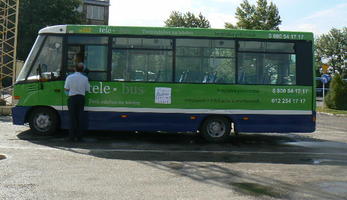Demand-responsive transport services in Krakow
Summary
The city of Krakow introduced and tested a new demand-responsive transport service in three districts. The service is the first such flexible public transport service In Poland and was based on the transfer of technology and know-how from Genova.
Implementing sustainable mobility
A main goal of implementing a demand-responsive transport (DRT) service in the southeastern part of the city was to improve the previously limited public transport offer and make it easer for citizens to reach the main transport interchanges. The service was created by three CARAVEL partners: Krakow’s public transport operator MPK; the Agency for Flexible Services in Genova (AMI), which supported MPK in the design and planning of the service and in developing the marketing campaign); and Softeco Sismat, Genova, which provided the DRT software and customised it to MPK’s needs.
The overall goal was to extend the reach of public transport and increase patronage in a selected area by introducing a service customised to passengers’ needs.
Progress
Following the design stage and the adaptation of software to local needs, MPK launched the TELE-BUS DRT service in July 2007. These activities were carried out with support from the Italian project partners AMI and Softeco.
The daily operations of the TELE-BUS flexible service are managed by the Transport Dispatch Center (TDC), which is part of MPK’s organisational structure. Clients contact dispatchers by phone using a special dedicated free number. The TDC also handles on-line booking, which must be completed by the client at least 30 minutes before the start of requested trip.
The new DRT service developed gradually during the first year, from 300 clients per month in the first quarter to more than 2,000 passengers in January 2008 and a subsequent stable monthly average of around 1,700 TELE-BUS users.
At the request existing and potential clients, the operator doubled the DRT network in March 2009. The service has its own regular clients, an important group being students attending local schools.
Outcomes
- Social acceptance for the new service: A continuous increase in the number of registered users proves the level of interest in this flexible public transport service.
- Increasing number of transported passengers: The number of passengers transported on conventional lines and by TELE-BUS vehicles has risen in comparison to the number during a similar period before the launch of the service.
- Cost increase in the initial phase: During the two years of DRT implementation, the TELE-BUS was an additional service provided in parallel with regular public transport services, and there was no reduction in the regular bus lines. As a result, the total costs of public transport were higher.
- Cost savings after two years: After doubling the TELE-BUS network and successfully cutting some of the regular bus lines in July 2009, the Public Transport Authority started to observe cost savings.







